As of this week, Japan has a new yokozuna, or ‘grand champion.’ Ōnosato Daiki triumphed at this year’s Natsu Basho – Summer Sumo Tournament – in Tokyo, to become the first Japanese wrestler to earn the coveted grand champion title in almost a decade.
This matters because while baseball is Japan’s most popular sport, with more than 26 million people attending professional league games each year, sumo is the country’s national sport. It is Japan’s ancient past brought to heaving, sweating life. And like the country as a whole, it finds itself at a crossroads: thriving, both at home and abroad, yet beset by major demographic and social challenges.
Sumo’s links with Shintō tradition are everywhere. Rice bales are placed around the ring, marking off sacred space. Overhead hangs a grand canopy constructed in the style of a Shintō shrine, complete with coloured tassles representing the four seasons. And buried in the centre of the ring is an unglazed earthenware pot containing offerings to the gods, including sacred sake.
Above: Ōnosato goes up against Gonoyama on Day 6 of the two-week Natsu Basho.
Below: Ōnosato celebrates his promotion to yokozuna.
When the wrestlers, or rikishi – literally ‘strong men’ – enter the ring, they throw purifying salt and perform their famous stomp to scare away evil spirits. They clap to attract the attention of the gods, raise their arms to show they are concealing no weapons, and cleanse their mouths with water.
Then, in front of a referee wearing the robes of a Shintō priest, it is down to business: the rikishi crouch on their marks and eye-ball each other in a prolonged act of psychological combat known as shikiri. The bout begins only when both wrestlers finally have both hands touching the ground. After that, if any part of your body but the soles of your feet touches the ground, or if you are forced from the ring, then you lose.
Sumo’s links with the gods can found, too, at a handful of shrines around Japan where bouts are held between a human being and a local deity:
To the mortal eye, only the human contender is visible, yielding the nickname hitori-zumo or ‘one-person sumo’ (the expression now doubles as a metaphor for inner struggle).
Quite how many people witnessing hitori-zumo sense the presence of two contenders is both hard to say and beside the point. Religion in Japan has long been a fascinating blend of ritual, play, humour and heightened awareness of the world. Sumo draws on all of this, while channelling and celebrating a certain kind of masculinity: discipline, character, focused aggression – and a little bit of swagger.
The sport’s human origins are said to go back to a nobleman and notorious braggart named Taima no Kehaya, who claimed in 23 BC that he was the strongest man ‘under the heavens’. The Emperor took offence and commanded a potter by the name of Nomi no Sukune to teach him a lesson. This he did, dealing Kehaya such devastating kicks to the ribs and back that he died the following day. Sukune is now remembered as the ‘father of sumo.’
Nomi no Sukune vs Taima no Kehaya, by the artist Tsukioka Yoshitoshi.
Sumo went on to serve, across the centuries, as a mixture of spectacle, strength training for aspiring warriors and religious ritual, performed in hopes of good harvests. Where early sumo was raw combat, with few if any rules, form and etiquette were gradually introduced: rings, rankings, winning techniques, ‘stables’ where wrestlers could live and train, and public tournaments – often held to raise money for good causes.
After Japan opened its doors to the modern West in the mid-nineteenth century, sumo wrestlers and samurai alike became symbols of a distinctly Japanese kind of masculinity: guardians of the country’s traditions against encroachment from abroad.
One of the best-known woodblock prints of a sumo wrestler dates from 1861 and shows him throwing a puny and over-dressed foreigner to the ground:
Yokohama Sumo Wrestler Defeating a Foreigner, by Ippōsai Yoshifuji.
Opinions differ in Japan over how well this sumo masculinity has aged. Critics note the long and largely unflattering history of women in the sport. The earliest recorded use of the word ‘sumo’ goes back to bouts between women in the fifth century AD, but these were topless matches arranged by the Emperor to try to distract a palace carpenter who had boasted that he never made a mistake. The Emperor’s plan worked: the flustered carpenter ended up damaging one of his tools and was duly executed.
More than a thousand years later, women once again returned to the sumo ring. But professional names like ‘Big Boobs’ and ‘Holder of the Balls’ tells you all you need to know about who the punters were and what they turned up to see.
Women now compete in sumo as amateurs, but at the professional level they are not even allowed to enter the ring, for fear of its defilement. This became a flashpoint issue in Japan back in April 2018 when the mayor of Maizuru city lost consciousness while he was giving a welcome speech from inside a sumo ring.
A number of women spectators, including a nurse, ran onto the ring to administer CPR, only to be ordered off again by a panicked-sounding announcer. A male emergency worker eventually took over, the ring was purified with salt and the tournament commenced – but not before a scene had played out, viewed millions of times online, which led commentators at home and abroad to question whether the rules on women’s participation laid down by the Japan Sumo Association (JSA) ought at long last to change.
If sumo has struggled with its rules on women, reflecting what critics charge is Japan’s broader failure to push the patriarchy from its perch, something similar has played out over the question of how welcome an addition non-Japanese rikishi might be to the ranks.
In July 1972, English was spoken for the first time from a sumo ring. A telegram from President Richard Nixon was read out, congratulating the Hawaiian wrestler Jesse Kuhaulua – better known as Takamiyama – for winning the Nagoya tournament.
Jesse Kuhaulua, a.k.a. Takamiyama
Some in the Japanese media nicknamed Kuhaulua kurobune: ‘black ship,’ recalling the unwelcome arrival off Japan’s shores of American gunboats back in 1853. Others questioned whether a foreigner could ever rise to the rank of grand champion, since that coveted title depends not only on a person’s qualities as a fighter but also his ‘outstanding character.’
The problem – or opportunity – for sumo, as for Japan as a whole, is that a shrinking population means difficult choices. An ever-smaller proportion of that population is now choosing to go pro in sumo. Football, basketball, rugby and baseball all represent more attractive careers for the sportily-inclined, not least because of the gruelling training (and eating) regime required of sumo wrestlers, at enormous cost to their health.
Hawaiian and, more recently, Mongolian wrestlers have begun to dominate the upper tiers of sumo as a result, dividing opinion between those who hanker after Japanese heroes and those who are impressed with the respect and dedication exhibited by foreign-born competitors.
To add to their list of woes, the Japan Sumo Association has been accused of slowness in dealing with bullying directed at young wrestlers by senior members of the stables where they train – intended to toughen up new recruits and in some cases to punish them for a lack of proper behaviour.
And yet despite these challenges, sumo in Japan is more popular than ever. A younger generation became hooked on it during lockdown and later through the sport’s growing presence online and via highly-publicised children’s competitions for girls and boys. Sumo got its Rocky moment in 2023, with the hit Netflix drama Sanctuary tracing the rise of a rookie wrestler, Enno, from dysfunctional beginnings to troubled superstar:
Real-life stars meanwhile serve as highly-effective hadaka taishi, ‘naked ambassadors,’ for their country or their region within Japan. And good seats for tournaments now sell out within hours, while tickets for tours abroad – including the Royal Albert Hall this October – are equally in demand.
Progressives in Japan recently noted with pleasure the decision of baseball superstar Shohei Ohtani to take parental leave to look after his baby. Might, they wonder, ‘Papa-tani’ encourage other Japanese men to do the same – in a country where child-rearing is still thought of primarily as women’s work? What wonders might female rikishi (suitably-attired) work on Japanese hearts and minds?
The question, for now, is moot. Female rikishi at the professional level seem no closer a prospect that women priests in the Catholic Church – and perhaps for broadly similar reasons. Just as it’s often said that the fastest-growing Christian denominations are the ones least prone to compromise with modern culture and shifting public opinion, so many in the Japan Sumo Association see their role as custodians of practices going back many centuries.
No doubt Japan will apply to sumo a little of its tried-and-tested formula for surviving and thriving in the modern world: a generous dollop of tradition gingered up with a splash of innovation and cutting-edge tech.
Expect foreign tours by major rikishi to see sumo gaining ever more in popularity abroad in the years ahead. And don’t be surprised if some serious money finds its way into supporting grassroots women’s sumo, raising it up to the point where men and women go head to head — if not in that sacred ring then at least in a competition for attention from fans both at home and abroad.
All the while, there'll be that heritage, that sense that when a rikishi stomps by in his kimono, you’re witnessing not just a bit of traditional culture but a presence that transcends history. And there will always be a hunger for that.
*
A version of this essay was first published at UnHerd.
—
Images
Ōnosato vs Gonoyama: Japan Times (fair use).
Ōnosato celebrates promotion: Japan Pool/JIJI/AFP/Getty/Guardian (fair use).
Nomi no Sukune vs Taima no Kehaya: Wikipedia (public domain).
Yokohama Sumo Wrestler Defeating a Foreigner: The Met Museum (public domain).
Jesse Kuhaulua: Star Advertiser (fair use).


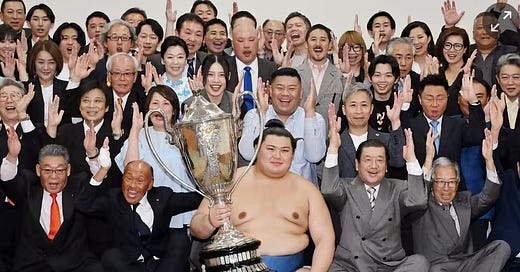


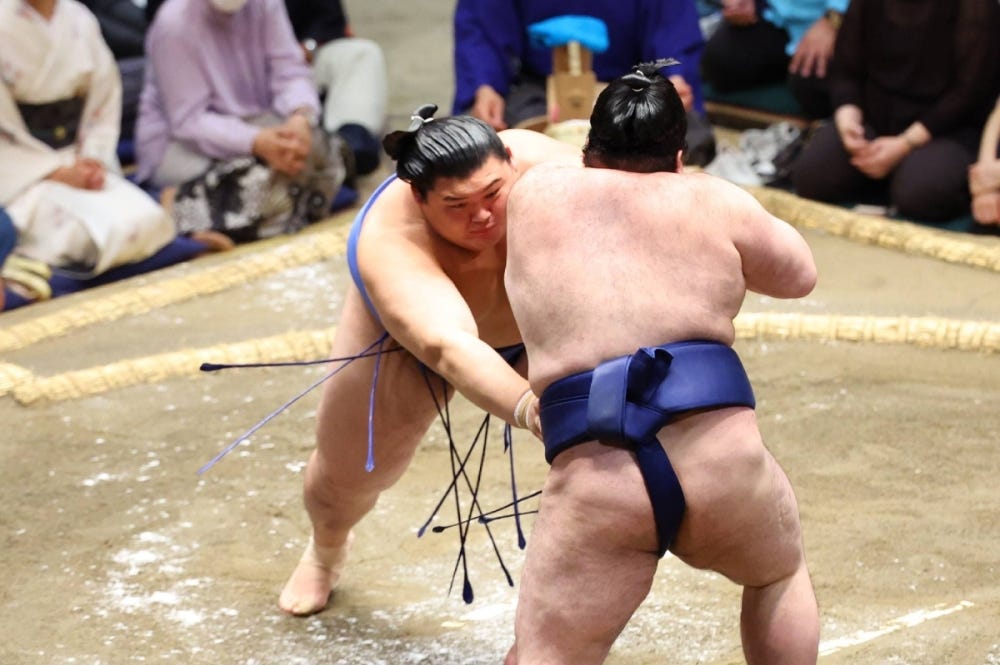
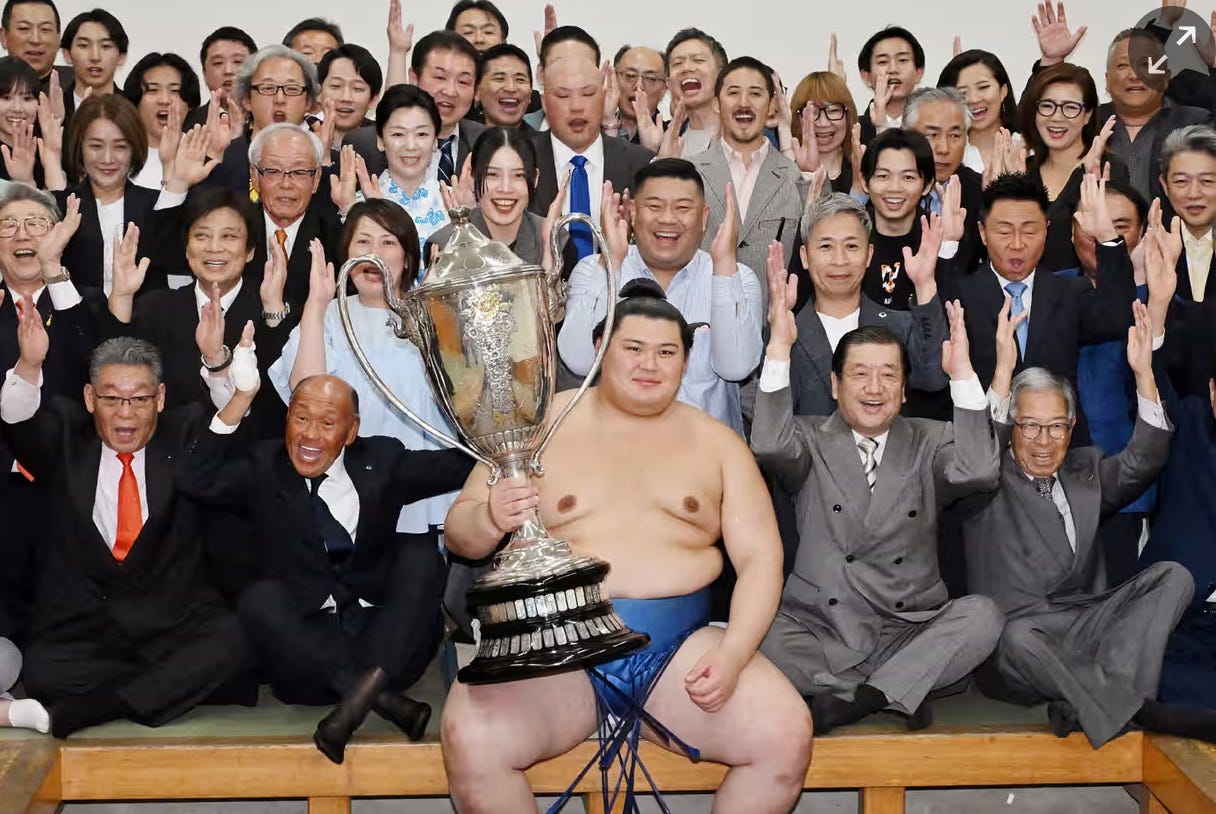
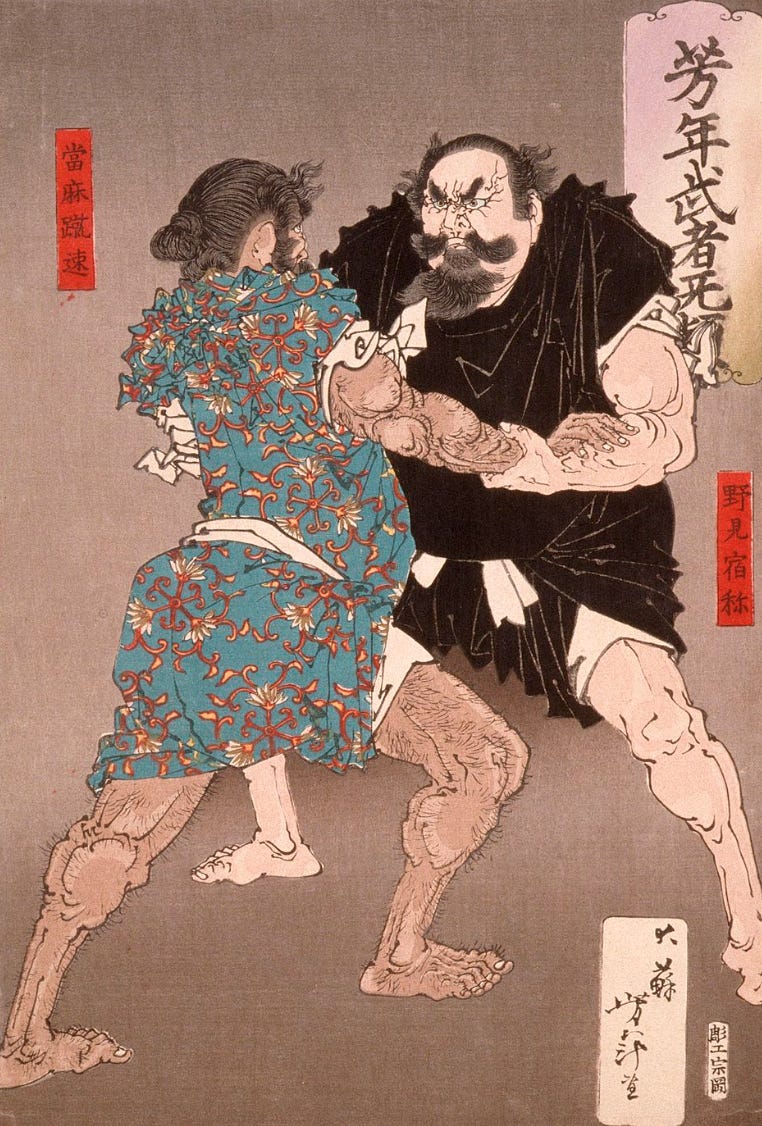
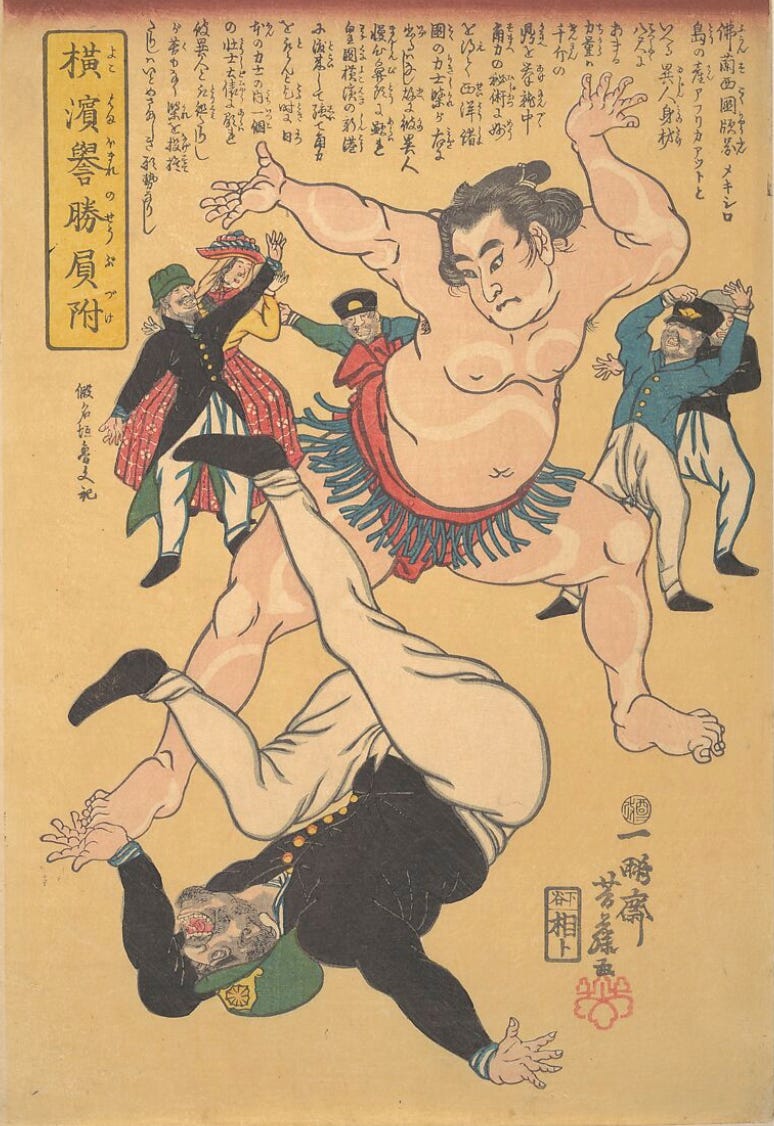
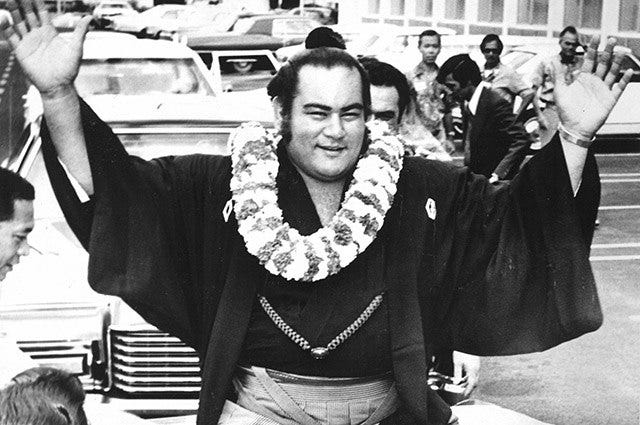
Incredible piece. Sumo feels like a metaphor for Japan itself: reverent, ritualistic, and wrestling (literally) with modern identity.
My wife and I were in Japan in July 1972 when Takamiyama won his tournament. The time and place and weather conditions were perfect for his amazing achievement. I think around exactly the same time, we were in Matsue when Lake Shinji discharged a huge amount of water into the town and flooded it. All transportation was stopped, and we walked out of the city in waist high water. Never forget that July.